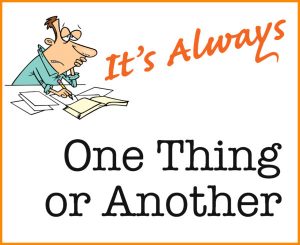On Dreamshaping: When the Body Speaks, Listen

Mark McNease
Audio PlayerOur bodies are often the first to tell us when something isn’t right, when something needs attention. They begin speaking to us almost as soon as we find ourselves in this strange environment we call our lives: they tell us we must breathe within moments after emerging from the womb; they tell us we must rid ourselves of waste, first with the abandonment of an infant, and later with the control we’re taught and that eventually determines much of how we function in the world. Our bodies tell us when change is upon us, in stages that can be as frightening as adolescence, or as sudden as a broken bone, or as marvelous as a first sexual response.
Our bodies are constantly speaking to us. Unfortunately, we often refuse to listen, believing we know better than our bodies, or being unable to understand what they’re telling us, or simply denying the truths they speak. Bodies are wild and natural, and taming them sometimes comes with a very high price. But we can begin to hear what they tell us, and by taking their advice we can live a freer, easier existence less burdened by pain and uncertainty.
On Dreamshaping: Letting Go Is Not Defeat

Mark McNease
Audio PlayerOftentimes the hardest part of letting go is simply not knowing what will take the place of the thing, person or situation we’ve allowed ourselves to relinquish. We may think the difficulty is in living without it, but upon closer inspection we discover that the real problem, and the impulse it creates to hang on, is being unaware what could possibly replace it. Comfort comes in many forms, including the illusion of certainty. Our routines, habits, assumptions, and repetitive thoughts all provide comfort—despite how uncomfortable we tell ourselves they make us! They offer reassurance that today will be as predictable as yesterday, and tomorrow will bring more of the same. Sameness is mistaken for safety. It allows us to be less fearful of what comes next.
Knowing that I have kept my life cluttered with the same things I want to be free from requires introspection that makes changing hard. I don’t want to admit these things bring order to my days. I may claim to be unhappy or displeased with my weight, or my behaviors, or my worldview, or my addictions, but they have provided me with continuity. I’ve trusted myself to wake up in the same dream since I was a child being told that dreams were beyond me, that I was limited and destined to achieve little in this world. Whose definition of achievement was another matter, and my resistance to that judgement, that taking measure of me, is among the reasons I survived. I wanted to see what could become of me, what experiences awaited in a new day, and I wanted to prove the assumptions wrong. Ultimately, the voices that tell us we are limited, and that play a part in our refusal to let go of the ordinary, become our own voices, the unwelcome narrator in our minds.
On Dreamshaping: Fear Itself

Mark McNease
Audio PlayerThe realization that many of the decisions we make throughout our lives are made from fear can be startling. Fear often determines the choices that shape our dreams and create our personal environments. When we’re children, we fear displeasing the adults in our lives, especially our parents. We watch them for signs of disapproval, and we become conditioned to pleasing them. Many times we succeed, and sometimes we fail. And it is the fear of failure, of not getting their approval or, worse, incurring their judgement, that sets a tone for our reactions to others, sometimes for the rest of our lives. I still recognize this impulse in myself in relationships, from the most intimate to the most casual. I tell a joke and watch to see if the person I’d told it to thought it was funny. Or I disparage someone who’d annoyed me, and I wait to see if my criticism is shared or if I should soften it with some kind of praise. Watching for the reactions of others is a lifelong human trait, and one of the things we watch for most is any reason to fear. Do they like me? Did they enjoy my book? Do they think I’m good at what I do? Or—and here comes the fear—do they think I’m a fakir, do they mock me when I’ve left the room, can they see the real me, for surely they won’t like it.
Fear wears many masks and offers many faces: the face of anger, insisting we have been wronged somehow or that we’ve lost the upper hand; the face of sorrow, immersed in the fear that we will never feel pleasure again; the face of gloom, our expressions set by the conclusion that the world we believed we lived in—our personal world, the world of our community and nation, even the planet—is changing for the worse. Fear undergirds it all. Fear is there beneath the surface, and if we’re willing to patiently scrape away those layers of anger, resentment, jealousy, insecurity, judgement, indignation, warpaint, we will find fear, the flame that provides the heat for it all.
On Dreamshaping: Enough Is Enough

Mark McNease
Audio PlayerIt’s not hard to observe the world around us and see how easy it is to live in a state of lack and fear: lack because we think that what we have is not enough, and fear of losing what we already possess! I’ve done it myself for an entire lifetime, starting as a child who needed validation and wanted more of whatever it was I had, on into adulthood where satisfaction and contentment have been fleeting and conditioned on believing, just for a few moments, that I was fulfilled. It’s the kind of completion I’ve felt after writing the last few lines of a novel, or winning some accolade that proved to me I was accepted. Those feelings of wholeness never last long, because they are not about who I truly am and want to be, but about markers of success, reassurances that I am not the failure I suspected I was.
On Dreamshaping: When Staying the Course Means Hitting the Iceberg

Mark McNease
How many times have we kept doing something because we were convinced it would have the result we wanted if we just kept doing it? We stayed the course despite possible detours or course corrections because it felt safer and more familiar to trudge ahead, even though the ground we walked on got softer and muddier and harder to free ourselves from.
Jobs are a good example of this. Relationships, too. We plow ahead, ignoring warnings and our own deep understanding that this work or this person is not helping us live the life we want. It doesn’t have to be a partner, either. It can be a friend or family member whose world view is so at odds with ours that we’re better off wishing them well in our hearts and putting them out of our lives.
On Dreamshaping: The Project Worksheet

Mark McNease
Audio PlayerWhether you call it a Dreamshaping Worksheet or a Project Worksheet, it’s one of the most valuable items in the Dreamshaper’s toolbox. I started keeping mine a year ago in the form of an Excel spreadsheet. It’s remarkably simple, and deceptively powerful. Why? Because it helps me see, right there in front of me, what I’ve accomplished in the previous weeks and months.

It’s so easy to become discouraged and think we’re not getting anywhere, or that we’re somehow stuck in the same small box we felt confined in yesterday and the day before. But by keeping an easy list or spreadsheet that we can add to every week, what we actually get done becomes clear – excitingly, irrefutably, invigoratingly clear! Each week, month by month, I record what I completed or started. ‘Sent out email to subscribers,’ or, ‘recorded interview with guest artist,’ or, ‘designed cover for new eBook.’ I may think I didn’t get anything done last week, but if I just take a look at the steps I took, the chapters I wrote, the podcasts I recorded and published – suddenly I know I’ve accomplished a lot. When we do this for an extended period of time, we may be the ones asking ourselves, ‘How do you manage to get so much done!’
On Dreamshaping: An Inside Job

Mark McNease
It’s not the thing the emotion attaches to, it’s the emotion.
It’s not the person or event the anger attaches to, it’s the anger.
It’s not the thoughts around which the confusion swirls, it’s the confusion itself.When I’m consumed by an emotion, even something as simple as anger aimed at another driver on the road, it’s the emotion that generates my state of mind, not the other driver. So many people have a need be angry, or even enraged, without ever comprehending that the object of their rage is not the issue: it is the rage, and the need for it, that lies at the heart of the experience.
One Thing or Another: Are We There Yet?

By Mark McNease
It’s always One Thing or Another… a lighthearted look at aging, life, and the absurdities of it all.
This column was always intended to be lighthearted, even in its most serious moments. Sure, I look at aging, life, and the absurdities of it all. I even ponder death now and then, since it’s pretty much the end point for all of us. Where we go after that, if we go anywhere, is not something I spend much time thinking or worrying about. I have appropriate clothes for any destination, or none at all, in case it’s especially hot.
But 2020 was so difficult, so groundbreaking, like a sledgehammer outside my bedroom window, that it stands unique among the years of my life. And now, two weeks into a new year, it’s still here! The same election we would normally have moved beyond by now, accepting it as part of the political bargain we make for living in a country where people are allowed to vote, keeps hold of us as if to prevent our escape. The frustrations of lockdowns and limited interactions and one-way grocery store aisles and the politicization of absolutely everything has us frayed within an inch of insanity. And that’s just Tuesday!